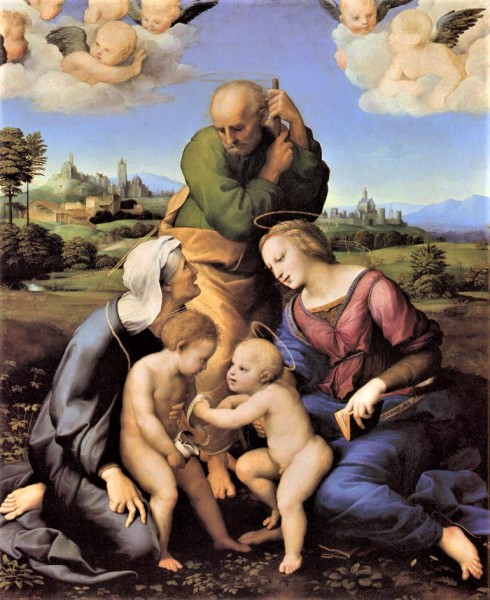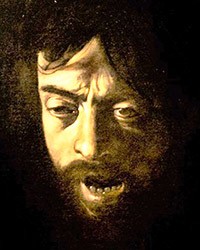The Holy Family with St. Elizabeth, the Young St. John the Baptist, and an Angel – a family meeting with an angel in the background

Orazio Borgianni, The Holy Family with St. Elizabeth, the Young St. John the Baptist, and an Angel, fragment, Galleria d’Arte Antica, Palazzo Barberini

Orazio Borgianni, The Holy Family with St. Elizabeth, the Young St. John the Baptist, and an Angel, Galleria d’Arte Antica, Palazzo Barberini

Orazio Borgianni, The Holy Family with St. Elizabeth, the Young St. John the Baptist, and an Angel, fragment, Galleria d’Arte Antica, Palazzo Barberini

Orazio Borgianni, The Holy Family with St. Elizabeth, the Young St. John the Baptist, and an Angel, fragment, Galleria d’Arte Antica, Palazzo Barberini

Orazio Borgianni, The Holy Family with St. Elizabeth, the Young St. John the Baptist, and an Angel, fragment, Galleria d’Arte Antica, Palazzo Barberini

Madonna with the Child, Saint Elizabeth and Saint Jan Baptist, Giulio Romano, Museo Nazionale di Capodimonte, Naples, pic. Wikipedia

Raphael, Madonna Canigiani, Alte Pinakothek, Munich, pic. Wikipedia

The Holy Family, Raphael, Musée du Louvre, Paris, pic. Wikipedia
The married couple of Mary and Joseph lean over their son in pious adoration, Mary’s aunt – Elizabeth (also a young mother) – is kneeling, holding her son John, who in the future will be given the nickname “the Baptist” and at the same time gently embraces her tiny relative – Jesus. He, with one hand, blesses his distant cousin, and with the other carefully touches the dove, that John is handing to him. The group is accompanied by an angel standing in the background, however, the viewer's eye focuses on the crib found in the foreground. It aroused such admiration of Roberto Longhi (an art collector and an expert on the works of Caravaggio and other artists close to him), that he called it "the most beautiful still nature of the Italian Seicento and one of the most beautiful in Europe at that time”.
The married couple of Mary and Joseph lean over their son in pious adoration, Mary’s aunt – Elizabeth (also a young mother) – is kneeling, holding her son John, who in the future will be given the nickname “the Baptist” and at the same time gently embraces her tiny relative – Jesus. He, with one hand, blesses his distant cousin, and with the other carefully touches the dove, that John is handing to him. The group is accompanied by an angel standing in the background, however, the viewer's eye focuses on the crib found in the foreground. It aroused such admiration of Roberto Longhi (an art collector and an expert on the works of Caravaggio and other artists close to him), that he called it "the most beautiful still nature of the Italian Seicento and one of the most beautiful in Europe at that time”.
The scene of two boys playing, accompanied by their mothers and Joseph, was not a new topic in art. It has been presented multiple times by artists from the previous century, including Raphael and Giulio Romano. Orazio Borgianni – the author of the painting in question – had to know them well. However, he introduced a new element into his composition. An angel with enormous wings playing the violin, because that is whom we are talking about, appears in Caravaggio’s painting Rest on the Flight into Egypt and he is the one, who is the prototype for the figure painted here. This is not the only element taken from the famous in the artistic world of Rome, Lombard. Orazio Borgianni, who had just returned from Spain (1606) – where his painting style fully developed – similarly to many of the Roman artists of those times admired the paintings of Caravaggio, found in churches all across the Eternal City and in private collections. And it was he who took over the tenebrism and naturalism of his scenes, even if this was only a momentary fascination. The typical for Caravaggio “bringing” the saints down to earth and placing them among the Roman populace was not what interested Borgianni, who was more concerned with depicting the holy scene in a somewhat idealized way, “profaned” only enough to show the human element of the story of Christ and his family. The painting ambitions of this artist concerned something entirely different. He desired to create a composition filled with details, in which – as in a book – one could follow individual parts of the story and recognize a deep religious message. It is as if he had wanted to boast about his broad knowledge, but also to enthrall the onlooker with the wealth of various types of physiognomic gestures, as well as exceptionally captured still natures.

Let us start – in an unusual way – with these very natures – since it would seem – they are the overture to the whole scene, as well as its epilogue. On the left, in the foreground, we can see objects connected with St. John (his attributes): camel skin, and a red shirt, which will be worn by John in the future as a hermit. There is also a thin reed cross, and a bowl for water used for baptism, as well as a small piece of paper with the word Dei, which is a short form of the formula Ecco Agnus Dei – Behold the Lamb of God, who takes away the sins of the world) – which are the words John will use to refer to Christ more than thirty years later meeting him in the desert when he will proclaim: “After me will come One more powerful than I, the straps of whose sandals I am not worthy to stoop down and untie. I baptize you with water, but He will baptize you with the Holy Spirit. In the Gospel, according to St. Mark (Mk 1, 7-11), we can also read: "In those days Jesus came from Nazareth in the Galilee and was baptized by John in the Jordan. As soon as Jesus came up out of the water, He saw the heavens breaking open and the Spirit descending on Him like a dove. And a voice came out of the heavens «You are my Son, the beloved; in You, I am well pleased »”. Therefore John handing his cousin a dove – the symbol of the Holy Spirit – anticipates the moment of the divine confirmation of the messianic role of Jesus during his baptism. The dove is of great significance here. In the Book of Genesis, it is the symbol of the covenant between the sinful world and God. In the New Testament, it is the symbol of the Holy Spirit. That is why upon the painting we see the future prophet – John the Baptist who was the first to recognize Jesus as the Messiah anointed with the Holy Spirit (“Behold I am sending my messenger ahead of You; he will prepare Your way before You” (Mt 1,1). St. John – foretold by the Old Testament predecessor of the Messiah – will not only recognize Christ the Savior, but also the one (as is testified to by the cross), who will take upon himself the burden of human sins and sacrifice himself upon the cross. Therefore, Borgianni shows the mystical encounter between Christ and John the Baptist, accompanied by the Holy Spirit in the form of a dove. In a symbolical significance, this was also a meeting between two Churches – the old (Jewish), represented by John the Baptist, and the new one (Christian) with Christ-God. In this sense, John is a figure symbolizing the law of the Old Testament, while Christ – the words of the Gospel.

On the right side of the painting, in the foreground, there is – the aforementioned – depicted with great precision and detail crib of the Son of God. It is a reference to the toddler years of Christ but is also an announcement of the grave and the white shroud which will cover the dead body of the Savior some thirty years later. In it, we can also see a scroll of paper, which of course symbolizes the Gospel.
And what of the other figures? The face of Elizabeth, filled with wrinkles – an old woman, but a young mother – is a testimony to the miracle of the birth of her son, that occurred when she was quite an elderly woman. Joseph, an old man, obedient to God, bends over his son – not his son. It was he, who was entrusted with the task and the gift of raising Jesus Christ. In the center of the composition, we see the beautiful Virgin Mary, with a halo over her head, dressed in a typical for her blue and red robe. And then there is the angel with imposing wings, playing the violin. Is he the same one, who appeared to Joseph in his dream, when he was filled with doubt as far as Mary's fidelity and had wanted to "divorce her quietly"? In a dream, the angel convinced Joseph that the baby she carries comes from the Holy Spirit, and Joseph believed him and was obedient. In the painting, he looks upon Jesus with tenderness and devotion. Or perhaps the angel is Uriel, known to us from the painting of Leonardo da Vinci (The Virgin of the Rocks) – the one who, according to one of the medieval apocrypha was to save John the Baptist from the slaughter of the innocents, during the escape to Egypt? And it was then, upon the desert, when John and Christ had met.

The composition of the painting is typically for Borgianni densely filled with colors, it is almost trembling. We are faced with a wealth of details but also the refined play of light and shade refracting on the folds of the robes, the harmony of the monochromatic colors, separated by the blue and delicate red of the robes of Mary in the central part.
We cannot be certain when exactly the painting was painted. However, it was probably before the painting dated 1608 entitled Madonna and Child with St. Anne by Carlo Saraceni – Borgianni’s friend and faithful companion, but also an artist with whom Borgianni, as was customary, exchanged creative ideas and experiences. We are also aware of the fact that the artists lend each other props (artificial wings for their angels, elements of armor, gypsum casting). The aforementioned, nearly identical crib, which filled Longhi with such admiration, will also appear in the work of Saraceni.
Initially, Borgianni's painting was found in the monastery of the Clarisses near the Church of San Silvestro in Capite. The monastery was taken over by the state in 1871 and a department of one of the ministries (of Public Works, Post Office and Telegraph Administration) was created there, but the canvas did not appear in the collections of the Galleria Barberini until 1922 after it was discovered by Roberto Longhi in the monastery complex (1916). Unfortunately, we do not know how it came into the possession of the Clarisses and who was its owner.
Orazio Borgianni, The Holy Family with St. Elizabeth, the Young St. John the Baptist, and an Angel, approx. 1606, oil on canvas, 257 x 202 cm, Galleria d’Arte Antica, Palazzo Barberini



























